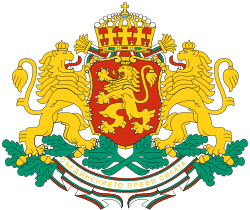Vratsa
| Vratsa Враца | ||
|---|---|---|
 | ||
| ||
| Motto: Vratsa, city like the Balkan - ancient and young. (Враца, град като Балкана - древен и млад.) | ||
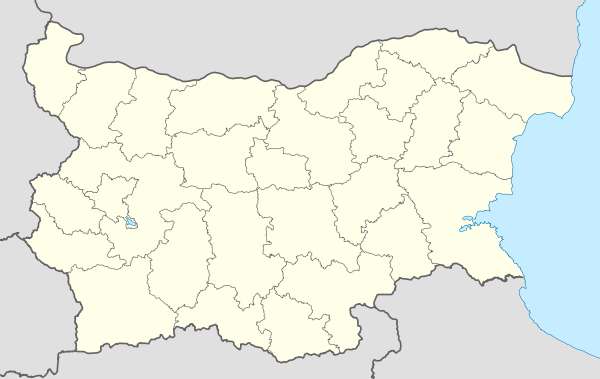 Vratsa Location of Vratsa | ||
| Coordinates: 43°12′N 23°33′E / 43.200°N 23.550°ECoordinates: 43°12′N 23°33′E / 43.200°N 23.550°E | ||
| Country | Bulgaria | |
| Province (Oblast) | Vratsa | |
| Government | ||
| • Mayor | Kalin Kamenov (GERB) | |
| Area | ||
| • City | 212 km2 (82 sq mi) | |
| Elevation | 344 m (1,129 ft) | |
| Population (Census February 2011)[1] | ||
| • City | 60,189 | |
| • Density | 280/km2 (740/sq mi) | |
| • Urban | 73,894 | |
| Time zone | EET (UTC+2) | |
| • Summer (DST) | EEST (UTC+3) | |
| Postal Code | 3000 | |
| Area code(s) | 092 | |
| Website | Official website | |
Vratsa (Bulgarian: Враца) is a city in northwestern Bulgaria, at the foothills of the Balkan Mountains. It is the administrative centre of the homonymous Vratsa Province.
The city of Vratsa is a commercial and crafts centre and a railway junction. Vratsa accommodates textile, metal processing, chemical, and ceramics industries.
Name
The name comes from the Vratitsa Pass nearby, from the Slavic word vrata ("gate") + the Slavic diminutive placename suffix -itsa, "little gate",[2] used to translate the Latin name Valve ("double door").
Geography
The city of Vratsa is picturesque. It is nestled in the foothills of "Vrachanski Balkan" (Vratsa Mountain), with the Leva River calmly crossing the city, and enormous and fearful rocks overhanging the roofs. The city is 116 km away from the national capital Sofia.
The area has diverse and attractive natural features, which together with the opportunities of recreation gives a special charm of the eastern part of the Northwest Bulgaria. Several protected natural attractions and historical monuments are located on the territory of the Vratsa State Forestry.
Climate
The climate is humid continental, similar to that of Sofia. The average annual temperature is about 11 °C (52 °F). Climate in this area has mild differences between highs and lows, and there is adequate rainfall year round. The Köppen Climate Classification subtype for this climate is "Cfb" (Marine West Coast Climate/Oceanic climate).[3]
Population
The number of the residents of the city reached its peak in the period 1990-1991 when exceeded 85,000.[4] As of February 2011, the town has a population of 60,692 inhabitants.[1] The following table presents the change of the population after 1887.
| Vratsa | |||||||||||||||
|---|---|---|---|---|---|---|---|---|---|---|---|---|---|---|---|
| Year | 1887 | 1910 | 1934 | 1946 | 1956 | 1965 | 1975 | 1985 | 1992 | 2001 | 2005 | 2009 | 2011 | 2013 | |
| Population | 11,323 | 15,250 | 16,177 | 19,620 | 26,582 | 39,091 | 61,134 | 75,451 | 75,518 | 68,975 | 63,260 | 61,011 | 60,692 | ?? | |
| Highest number 85,272 in 1990 | |||||||||||||||
| Sources: National Statistical Institute,[1][4][5] „citypopulation.de“,[6] „pop-stat.mashke.org“,[7] Bulgarian Academy of Sciences[8] | |||||||||||||||
Ethnic, linguistic and religious composition
According to the latest 2011 census data, the individuals declared their ethnic identity were distributed as follows:[9][10]
- Bulgarians: 53,275 (97.3%)
- Gypsies: 1,045 (1.9%)
- Turks: 54 (0.1%)
- Others: 185 (0.3%)
- Indefinable: 216 (0.4%)
- Undeclared: 5,937 (9.8%)
Total: 60,692
The ethnic composition of Vratsa Municipality is 64334 Bulgarians and 2215 Gypsies among others.
History
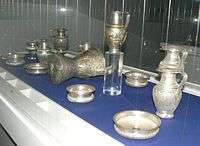
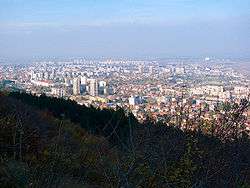
Vratsa is an ancient city found by ancient Thracians. Vratsa was called Valve ("door of a fortress") by the Romans due to a narrow passage where the main gate of the city fortress was located. Nowadays, this passage is the symbol of Vratsa, and is shown on the town's Coat of arms.
After the fall of Rome, Vratsa became part of the Eastern Roman Empire (Byzantium).
At the end of the 6th century AD, Vratsa was populated by the South Slavic tribes. Even if they came from Pannonia and Dacia on the north, the town remained under Byzantine rule.
In the 7th century, the Bulgars and the Slavs found the First Bulgarian Empire and the Slavic Vratsa became part of it. The city grew into important strategic location because of its proximity to the South State border. Vratsa became famous for its goldsmiths and silversmiths production and trade, high-quality earthenware and military significance.
In the 8th century, the Bulgarian army captured Sofia, which led to the decreasing of Vratsa's importance because of the better strategic position of Sofia, its more developed economy and larger size. But Vratsa was again key for the resistance against the Byzantine, Serbian and Magyar invasions in the Middle Ages.
Tourism
The mountains and forests are suitable for development of different types of tourism — hunting and fishing, skiing, speleology, delta-gliding, photo-tourism, etc.
Good opportunities exist for exercising different sport activities such as mountaineering, bicycle sport and for those who enjoy being thrilled can go for hanggliding and paragliding, or set out for carting, buggy and motocross racing tracks.
Conditions are provided for rest and entertainment — children's and adults' swimming pools, water cycles, discos, bars, restaurants, excellent hotel facilities and good service. If you are a fervent admirer of winter sports you will be glad to hear that the rope lines near the Parshevitsa Chalet are working, and the skiing tracks are well maintained.
There are also a Museum of History and an Ethnographic and Revival Complex.
Climate
Vratsa has a humid subtropical climate with some continental effects.
| Climate data for Vratsa (2002-2012) | |||||||||||||
|---|---|---|---|---|---|---|---|---|---|---|---|---|---|
| Month | Jan | Feb | Mar | Apr | May | Jun | Jul | Aug | Sep | Oct | Nov | Dec | Year |
| Average high °C (°F) | 3.2 (37.8) |
5.8 (42.4) |
11.0 (51.8) |
17.5 (63.5) |
23.1 (73.6) |
26.8 (80.2) |
29.5 (85.1) |
29.7 (85.5) |
25.3 (77.5) |
18.4 (65.1) |
11.6 (52.9) |
5.3 (41.5) |
17.3 (63.1) |
| Daily mean °C (°F) | −0.6 (30.9) |
1.6 (34.9) |
6.4 (43.5) |
12.5 (54.5) |
18.1 (64.6) |
21.8 (71.2) |
24.1 (75.4) |
24.1 (75.4) |
20.0 (68) |
13.5 (56.3) |
7.9 (46.2) |
1.8 (35.2) |
12.6 (54.7) |
| Average low °C (°F) | −4.3 (24.3) |
−2.7 (27.1) |
1.8 (35.2) |
7.5 (45.5) |
12.1 (53.8) |
15.8 (60.4) |
17.7 (63.9) |
17.5 (63.5) |
13.6 (56.5) |
8.5 (47.3) |
3.7 (38.7) |
−1.4 (29.5) |
7.5 (45.5) |
| Average precipitation mm (inches) | 48 (1.89) |
41 (1.61) |
52 (2.05) |
71 (2.8) |
112 (4.41) |
106 (4.17) |
78 (3.07) |
61 (2.4) |
59 (2.32) |
65 (2.56) |
62 (2.44) |
54 (2.13) |
809 (31.85) |
| Source: Stringmeteo.org | |||||||||||||
Main sights
Ledenika cave
Ledenika is the most frequently visited Bulgarian cave.
Ledenika is located in the Stresherski part of the Vratsa mountain. Its entrance being at 830m above sea level. It features an abundance of galleries and impressive karst formations including stalactites and stalagmites, dating back a thousand years. The cave is about 300m long and contains ten separate halls. The cave is part of the 100 Tourist Sites of Bulgaria
Vratsata Gorge
Vratsata Gorge – the highest cliffs on the Balkan Peninsula (400 meters high).
Vratsata Gorge is situated in Vratsa Mountain. The area is easily accessible from Vratsa.
The limestone of Vratsata Central Wall and the other rocks offer many possibilities for climbing and alpinism, connected by more than 70 alpine routes of all categories of difficulty.
Skaklya waterfall
Skaklya waterfall - highest temporary waterfall in Bulgaria - 141 meters.
Regional historical museum
Regional historical museum in Vratsa preserves the Rogozen Treasure - the biggest Thracian treasure that was ever discovered on the territory of Bulgaria[11][12]
The main building of the museum houses several exhibitions.
- Prehistory Hall
- Antiquity Hall
- The Middle Ages Hall
- The Thracian Treasures Hall
- The Rogozen Treasure Hall
- Hristo Botev exhibition Hall
- New History Hall
- Stone arc Hall
- Lapidarium.
Panoramic Views



Transport
The strategic location of Vratsa is determined by the major rail and road corridors. Its geographical position will become even more important with the construction of the Danube Bridge 2 at the town of Vidin (providing the most direct land access from the Thessaloniki port and Sofia towards Western Europe). Vratsa connects to the villages and city within the region and throughout the country by bus and railway transport. There are regular bus lines to Sofia, Pleven, Vidin, Montana, Kozloduy, Oryahovo, Mezdra (at short intervals), as well as to the smaller villages, scattered around the city. The bus station is located on the way between the railway station and the centre of the city. Vratsa is an important railway station along the railway route Sofia — Vidin (Lom).
Honour
Vratsa Peak on Greenwich Island in the South Shetland Islands, Antarctica is named after Vratsa.
In popular culture
Vratsa is the home of a professional Quidditch team operating within the fictional Harry Potter universe. The Vratsa Vultures have won the European Cup seven times.[13]
Twin cities
Vratsa is twinned with:[14]
Gallery
- Ledenika cave
 Vratsa by night
Vratsa by night- Vratsata gorge
 Street scene
Street scene Ethnographic complex
Ethnographic complex Theatre
Theatre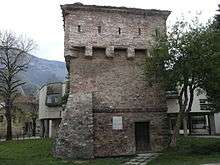 Medieval Tower of Kurt Pasha
Medieval Tower of Kurt Pasha Medieval tower
Medieval tower Tourist centre
Tourist centre School
School- Street in Vratsa
 Vratsa in the winter
Vratsa in the winter
References
- 1 2 3 (Bulgarian)National Statistical Institute - Main Towns Census 2011
- ↑ "Враца— кратка справка" (in Bulgarian). PureBulgaria. Retrieved 2008-09-14.
- ↑ "Vratsa, Bulgaria Köppen Climate Classification (Weatherbase)". Weatherbase.
- 1 2 (Bulgarian)National Statistical Institute - Towns population 1956-1992
- ↑ (English) Bulgarian National Statistical Institute - towns in 2009
- ↑ (English) „WorldCityPopulation“
- ↑ "Cities of Bulgaria". mashke.org.
- ↑ (Bulgarian) Bulgarian Academy of Sciences
- ↑ (Bulgarian) Population on 01.02.2011 by provinces, municipalities, settlements and age; National Statistical Institute
- ↑ Population by province, municipality, settlement and ethnic identification, by 01.02.2011; Bulgarian National Statistical Institute (Bulgarian)
- ↑ http://vratsamuseum.ovo.bg/virtualen_musei/EVK/index.html
- ↑ https://web.facebook.com/regionalhistoricalmuseumvratsa?ref=hl&_rdr
- ↑ Whisp, Kennilworthy (2001). Quidditch Through the Ages. WhizzHard Books. pp. 31–46. ISBN 1-55192-454-4.
- ↑ "Official Site of Municipality of Vratsa". vratza.bg.
External links
| Wikimedia Commons has media related to Vratsa. |
- Vratsa Municipality website
- Hotels in Vratsa (map)
- Vratsa Historical Museum
- “Vrachanski Balkan” Nature Park
Pictures
- Photos from Vratsa (Facebook)
- 360° virtual panoramas from Vratsa
- Photo Gallery Vratsa and villages from the region

